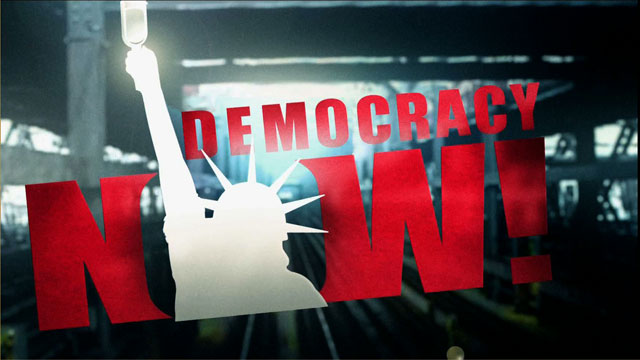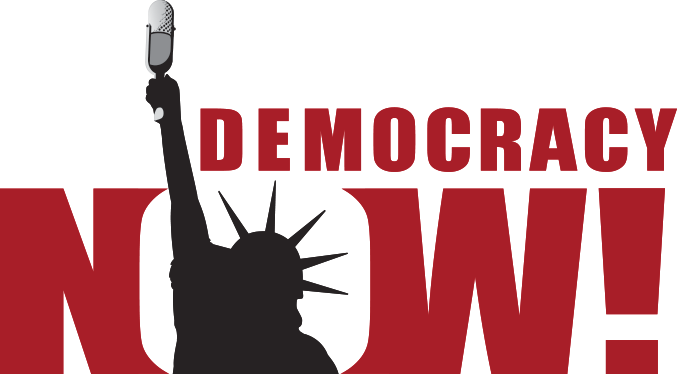
Guests
- Kal Wagenheimthe co-author of The Puerto Ricans: A Documentary History and editor of Caribbean Update, a monthly newsletter on business in the Caribbean region.
The House vote earlier this month on the future of Puerto Rico’s status sparked renewed interest in the oldest and largest colony of the United States. And today on the island, many Puerto Ricans will be remembering one of the most seminal events in the country’s relations with the United States: the Ponce massacre, a massacre that to this day informs the debate on statehood versus independence.
Transcript
AMY GOODMAN: You are listening to Pacifica Radio’s Democracy Now! I’m Amy Goodman, here with Juan González. Juan, the other night, I went into a Barnes & Noble in New York City — talking about commercial enterprises — but I went to get some books on Africa for President Clinton’s trip there, and I was just pleasantly surprised to see that Angela Davis was walking in and about to give a talk. And at the end of her talk, the first person who got to ask a question asked her about political prisoners.
ANGELA DAVIS: OK, there are about 100 political prisoners still behind bars, including large numbers of —
AMY GOODMAN: This is Angela Davis.
ANGELA DAVIS: — Puerto Ricans who are in prison only because they are fighting for the independence or fighting against the colonial subjugation of Puerto Rico. As a matter of fact, I live about 15 minutes from the jail, from the federal prison, federal correctional institution for women, where Dylcia Pagán is being held, Carmen Valentín, Alicia Rodríguez. The other political prisoners there, Marilyn Buck, who was charged with helping Assata Shakur to escape; Laura Whitehorn — Laura Whitehorn and Linda Evans are there, as well. So, yeah.
AMY GOODMAN: I just thought that was interesting to introduce this segment, because people don’t hear a lot about Puerto Rican political prisoners. She went on to talk about the Jericho March that is happening next week, Jericho ’98, where people from around the country will be marching on the White House to demand that the U.S. government free all political prisoners. But very few people know about their history. And political prisoners who are in this country as a result of Puerto Rico have been fighting for independence and have been shaped by a number of seminal events in Puerto Rican history.
JUAN GONZÁLEZ: Yes, there are 15 Puerto Rican political prisoners still in U.S. jails, all of them for organizing and advocating and fighting for independence for Puerto Rico. But this is only the recent generation. Tomorrow will be the 61st anniversary of the Ponce massacre. Actually, that’s where I was born, in Ponce. In Ponce, Puerto Rico, on Palm Sunday, March 21st, 1937, there was a peaceful protest of the members of the Nationalist Party of Puerto Rico, which was then the largest pro-independence party on the island, and the police tried to block the march and ended up opening fire. And when the smoke had cleared, there were, I think, 21 people dead and somewhere near between 150 to 200 wounded.
And we have with us today, Kal Wagenheim, who is the co-author of The Puerto Ricans: A Documentary History and is also the editor of Caribbean Update, a monthly information publication for corporate business throughout the Caribbean and the United States. And I want to welcome Kal Wagenheim so we can talk a little bit about this almost totally forgotten incident in U.S. and Puerto Rican history, the Ponce massacre. So, I’d like to welcome Kal Wagenheim to Democracy Now!
KAL WAGENHEIM: Good morning.
JUAN GONZÁLEZ: Kal, could you tell us a little bit about the events leading up to March 21st, 1937, what was happening in Puerto Rico at the time and just who the leaders of the Nationalist Party were?
KAL WAGENHEIM: Well, I think it’s important to understand the context and to remember that in 1898, which was just 39 years earlier, the United States had invaded Puerto Rico during the Spanish-American War and had taken over the island without a consultation with the people, and the United States installed a classical colonial regime at the time. A governor was appointed by the president of the United States. It was an American. He would be sent to Puerto Rico. The chief of police of Puerto Rico was an American. So you didn’t really have any real form of democracy on the island.
In addition to that, ever since the 1920s, Puerto Rico had been suffering particularly from the worldwide Depression. It was a poor island to begin with, and the Depression just caused even more misery. You had unemployment of 35 to 40%. Washington, unlike in more recent years where there have been, you know, some efforts at a war on poverty and some flow of federal funds, Washington was very stingy in that respect in those days. So, in a sense, Puerto Rico was receiving nothing from Washington, either, you know, democratic power or any kind of federal benefits.
So, understandably, there was a tremendous amount of dissent. And you had some very dedicated, idealistic young men and women on the island who, in some ways, were even inspired in the 1920s by the example of the Irish Free State, the people striving for independence from England, and these were led largely by Pedro Albizu Campos, a young man from a poor family in Ponce who had gone to Harvard, graduated, I think, with some distinction up there, had actually served in the U.S. Army as an officer in World War I, but he came back and became a lawyer specializing in labor law and was convinced that nationalism was the one answer for Puerto Rico, that Puerto Ricans had to become independent, just really as a question of pride and dignity. So he began a series of protests and all kinds of activities.
The nationalists were not pacifists. I don’t think we should mischaracterize them. They were militant people. I don’t think they were looking for trouble, but they were quite militant. There were some violent encounters between the nationalists and the police authorities in Puerto Rico, who, you know, regarded them as a threat and a menace.
But then, this — as you say, Juan, on Palm Sunday 1937, this was supposed to be just a parade in the town of Ponce. They had received a permit from the mayor of the town, but at the last minute, this was canceled by the Puerto Rican insular authorities. It was really almost a provocation by the authorities to cancel this at the last minute. And the marchers just decided to defy the last-minute cancellation, and they began marching. And no one really knows exactly what happened, except no one saw any of the marchers with weapons, but suddenly a shot rang out. There was a tremendous fusillade of, you know, bullets. And at the end of it all, a couple of police officers were killed also, but the great majority of those dead and wounded were defenseless, young men and women and some children. So, that’s really what happened. The American Civil Liberties Union actually came in at some point to investigate, at the invitation of some of the civil rights activists in Puerto Rico, and they concurred with the local civil rights activists that this had been a massacre. That’s why it’s called the Ponce massacre.
JUAN GONZÁLEZ: Now, interestingly enough, the folks who were gathering — at that very time, Pedro Albizu Campos and Juan Antonio Corretjer and many of the other leaders of the Nationalist Party were in jail, because they had been convicted of seditious conspiracy, and they were actually awaiting appeal. So this was actually a protest over political prisoners at that time, for the freeing of the political prisoners then. In terms of the impact that this had on the island, because, clearly, for such a small island — the population may have been about a million and a half at that time — to have this many people on one day wounded and killed — what was the impact on the island after that?
KAL WAGENHEIM: Well, I mean, it was a tremendous impact on the island itself. People were shaken up by this, by this violence. And I think it also had an impact in Washington. I think in Washington, they began to realize that all was not — you know, all was not hunky dory on this little Caribbean island. And I think they began to be concerned about it and began to put into motion some reforms. They began to try to transfer some of the New Deal programs into Puerto Rico to help alleviate the poverty there, and eventually put into motion a process that would lead to a greater degree of self-government in Puerto Rico.
It would be 1946, I think, where finally the president of the United States appointed a Puerto Rican, rather than an American, to be the first Puerto Rican governor of the island. And then, two years later, elections were allowed, where Puerto Ricans for the first time elected their own governor, and have been electing their own governor ever since. And then, also, a greater degree of autonomy was granted with a constitutional change in 1950.
So, I would say that the nationalists, to a very important extent, by their pressure and their militance, kind of this was a wake-up call for Washington. Washington did not grant independence, but it certainly budged and granted a much greater degree of political democracy, local autonomy, if you will, and began a flow of more federal aid to the island.
JUAN GONZÁLEZ: Well, you know, my family, as I said, came from Puerto Rico, and my aunts and uncles still recall as children the day of the Ponce massacre and often talk about it, because after that, it sort of became — to be a nationalist in Puerto Rico was to be basically hunted, not be allowed to work in government jobs or as teachers. So, from that period on, the repression increased considerably. Interestingly, this happened under Franklin D. Roosevelt, and Harold Ickes was the secretary of the interior at the time, the father of the currently well-known Harold Ickes, and Ickes was actually a member of the American Civil Liberties Union, so that even though the U.S. government and Congress did not investigate the massacre, the ACLU, as you said, did.
AMY GOODMAN: Juan, when you say “nationalist,” just to clarify for listeners who are not as familiar with Puerto Rican history, you mean those who want independence for Puerto Rico.
JUAN GONZÁLEZ: Right. The Nationalist Party, right. Everyone called them los nacionalistas, the members of the party.
KAL WAGENHEIM: Yeah, well, it was a particularly militant wing of the people who sympathized with them for independence. There were others who were just called independentistas, who maybe were not nationalists, but the nationalists were a particularly militant wing of the pro-independence movement, which was a far wider movement than, you know, a lot of people realize. At one point in an election in the 1940s, the Independence Party gained something like a quarter of the vote. The nationalists were people who were willing to just stick their necks out and march and openly demonstrate, etc., because they were particularly adamant about gaining independence for the island.
JUAN GONZÁLEZ: The report of the ACLU that you mentioned, I have one of the quotes from that report by the — the committee was actually headed by Arthur Garfield Hays. And it says, quote, “When we began our investigation, we objected to naming our committee the Committee for the Investigation of the Ponce Massacre. To refer to the Ponce tragedy, we used the Ponce Case, the riot, or any other phrase that should demonstrate our intention of dealing objectively with the facts. Now that we have heard all the proofs, we agree that the people of Ponce had given this tragedy the only title it can possibly have: The Ponce Massacre.” It turns out also that they note that the district attorney of Ponce at that time resigned rather than follow the orders of Governor Blanton Winship, the American governor at the time, and other Puerto Rican authorities to prosecute the protesters. In terms of the impact of Albizu Campos as a whole, because he was in jail at the time and spent many more years in jail, what became his impact as a figure in the history of Puerto Rico?
KAL WAGENHEIM: I think today, just about everyone in Puerto Rico, whether or not they agreed with his extremely militant stance, views him as a figure of respect, because everyone, I think, acknowledges the fact that he was, you know, spurred on by very pure ideals to establish a country, that he was a brave man. Not everyone agreed with his methods, if you will. Some people, even those who don’t agree with him, look at him as a kind of a quixotic figure, you know, tilting at the great big windmills of the United States, but certainly as a brave and idealistic man.
And in a sense, he was — he and his followers were, in some ways, really victims of a much larger situation at the world level. They came on the scene struggling for independence at a time when the United States, in the beginning of World War II, was engaged in a worldwide struggle. The policymakers in Washington looked at any kind of turmoil in Puerto Rico as something that was disturbing the geopolitical balance in the Caribbean. And then, after World War II, you had the Cold War, where, again, any kind of — you know, any kind of lack of stability in the Caribbean was viewed as very bad in terms of Cold War politics. The United States had FAC Air Force bases on the island and a very large naval base.
So, in some ways, you know, the nationalists received not only — they were oppressed not only by the local police authorities, but the entire federal apparatus. The FBI, etc., also cracked down on them very harshly. The nationalists, in many cases, were jailed not for what they did, but for even what they said. There were very strict laws against what were called seditious speech. And Albizu Campos would make a speech, very militant speech against U.S. colonialism, and there would be a police stenographer in the crowd who would take down these words. And then he would arrested for seditious speech.
JUAN GONZÁLEZ: Well, Kal Wagenheim, we’re going to have to close this session, but I really thank you for being with us. And we’re going to be continuing our coverage. This 100th anniversary of colonialism in Puerto Rico, we’re going to continue to be having other segments dealing with some of the history and the present situation in Puerto Rico.
AMY GOODMAN: That’s right. And April 21st is the anniversary of the death of Pedro Albizu Campos, and we’ll be doing more on him, as well. Kal Wagenheim, co-author of The Puerto Ricans: A Documentary History, thank you for joining us. Folks, if you’d like a copy of today’s show, you can order a cassette from the Pacifica Archives by calling 1-800-735-0230. That’s 1-800-735-0230. Our email address, democracy@pacifica.org. Democracy Now! is produced by Dan Coughlin. Jeremy Scahill is our director; Errol Maitland, our engineer; Julie Drizin, our executive producer. Monday, we’ll be dealing with Africa. President Clinton is headed there with about 200 journalists and others. I’m Amy Goodman, with Juan González. Thanks for listening to another edition of Pacifica Radio’s Democracy Now!, from the studios of WBAI in New York.












Media Options